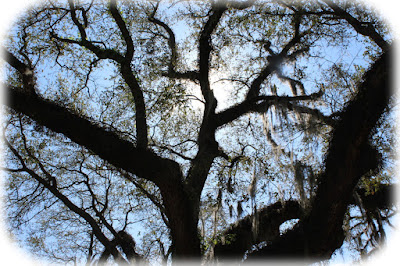There's a reason why I take so many pictures of trees. It’s obvious that trees make a significant contribution to any community, and since nearly all of them are older than I am, I treat them with respect and admiration.
For one thing, they have roots. They are fully rooted in the life of the community, providing shade for hard working people over the years, giving the youngsters a natural gym and climbing wall, maybe a place to build a tree house.
Some trees are historic. They have seen hundreds of years of history pass under them: Post Oak in Madisonville, the Seven Sisters Oak in Lewisburg, the Sunnybrook oaks.
The Lumber Industry
St. Tammany's economy began with trees, with timber being cut, and lumber being processed and shipped to New Orleans and many points beyond. Hundreds of thousands of people built their homes of 2 x 4 studs that
were once part of the St. Tammany landscape.
Many of those trees helped make paper, onto which your newspapers are printed and read by thousands daily to share local goings on as well as the world news. Paper also goes into the endless parade of books being published. Some of that paper goes into cardboard boxes, which now shelter your treasured keepsakes in the attic, help people move their belongings from coast to coast, and protect and transport the products that are trucked to your local store where they are taken out of the box and put on shelves.
Some of that lumber went into the making of millions of pallets, which are used by shipping concerns around the world. Trees are what are called a "renewable resource" as more trees are planted to replace the ones converted to lumber and paper.
Trees Are Artists
Trees are also artists, lifting up a network of twisted limbs framing the blue of the sky in a mosaic of shapes and shades. They entertain us with the different textures of their barks, the ground-level network of knots and knees. In the spring, they inspire us with green leaves and buds; in the fall, they astound us with oranges and yellows and reds, leaves in a rainbow of colors, which then all fall to the ground and give us the endless pleasure of raking them all up (or blowing them from one end of the yard to the other.)
The physics of a tree amazes me. The huge network of roots underneath the ground somehow supports, stabilizes and makes possible the huge network of limbs overhead. It's hard to imagine the weight of the heavy limbs, pulling mightily at the main trunk, the off balance leaning of the top canopy, the tensile strength of wood fibers, the conveying of water from deep in the ground to the tip tops of the branches, the swaying back and forth in the gentle breezes, the violent contortions of being buffeted by hurricane-force winds, 100 miles per hour winds.
Which brings me to why I wrote all this: I will miss the trees brought down by Hurricane Ida. The dense canopy of treetops has been thinned out considerably, the tall pines toppled, people’s homes and cars shattered.
The trees tried to hold on, but the twists and jerks of the wild bursts of winds overcame them. Many just keeled right over after hours and hours of rain-soaked ground gave way, their roots pried from the nurturing dirt, their limbs on the way down taking out powerlines and cable wires, rafters, ceiling joists, and walls. Thousands upon thousands of light poles were smashed and snapped, and
many more trees will have to be cut down to replace those light poles.
The trees didn’t want to damage anything. The trees just wanted to live and grow and provide leaf mulch for years to come. But now those trees that fell have been sawed into sections, stacked on the side of the road, picked up by a mechanical claw and placed in big metal dumpsters on wheels. They are being taken somewhere else where we cannot see their undignified remains as they rot or get shoved into a chipper.
There are still many trees, of course, some of which will be taken down as a precaution against future storms sending them crashing down into nearby homes and automobiles.
I’ve known people who live out west, in towns with few if any trees. When they come to Louisiana they are amazed by the trees, the moss, and the tree-cradled ferns, the lattice of limbs where birds nest and squirrels romp.
I send the visitors to the lakefront in Mandeville, where they can enjoy a variety of trees of all shapes and sizes. It's a place to marvel at the trees, sit under them and think about things in a quiet and thoughtful manner, as people have done for centuries, sitting under those very same trees that have stood there for centuries, and hopefully for many more years to come.
See also:














